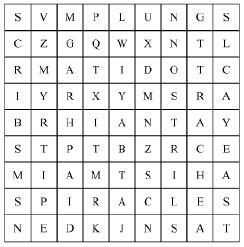Respiration in Organisms
Match the items in Column I with those in Column II:
| A. Yeast | (i) Earthwormc |
| B. Diaphragm | (ii) Gills |
| C. Skin | (iii) Alcohol |
| D. Leaves | (iv) Chest cavity |
| E. Fish | (v) Stomata |
| F. Frog | (vi) Lungs and skin |
A. Yeast | (i) Alcohol |
B. Diaphragm | (ii) Chest cavity |
C. Skin | (iii) Earthwormc |
D. Leaves | (iv) Stomata |
E. Fish | (v) Gills |
F. Frog | (vi) Lungs and skin |
Sponsor Area
Some More Questions From Respiration in Organisms Chapter
Mark ‘T’ if the statement is true and ‘F’ if it is false:
Given below is a square of letters in which are hidden different words related to respiration in organisms. These words may be present in any direction − upwards, downwards, or along the diagonals. Find the words for your respiratory system. Clues about those words are given below the square.

(i) The air tubes of insects
(ii) Skeletal structures surrounding chest cavity
(iii) Muscular floor of chest cavity
(iv) Tiny pores on the surface of leaf
(v) Small openings on the sides of the body of an insect
(vi) The respiratory organs of human beings
(vii) The openings through which we inhale
(viii) An anaerobic organism
(ix) An organism with tracheal system
The mountaineers carry oxygen with them because:
(a) At an altitude of more than 5 km there is no air.
(b) The amount of air available to a person is less than that available on the ground.
(c) The temperature of air is higher than that on the ground.
(d) The pressure of air is higher than that on the ground.
Mock Test Series
Sponsor Area
NCERT Book Store
NCERT Sample Papers
Sponsor Area